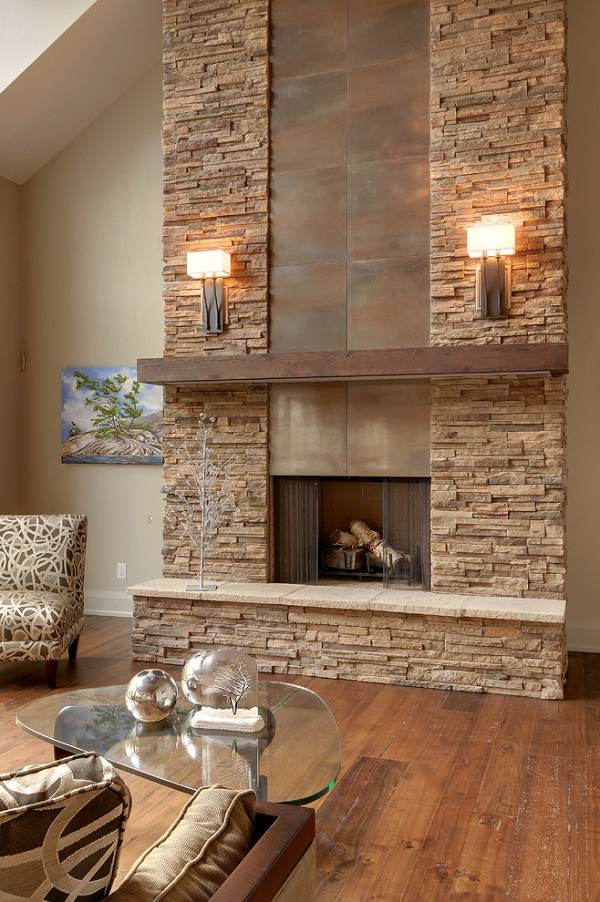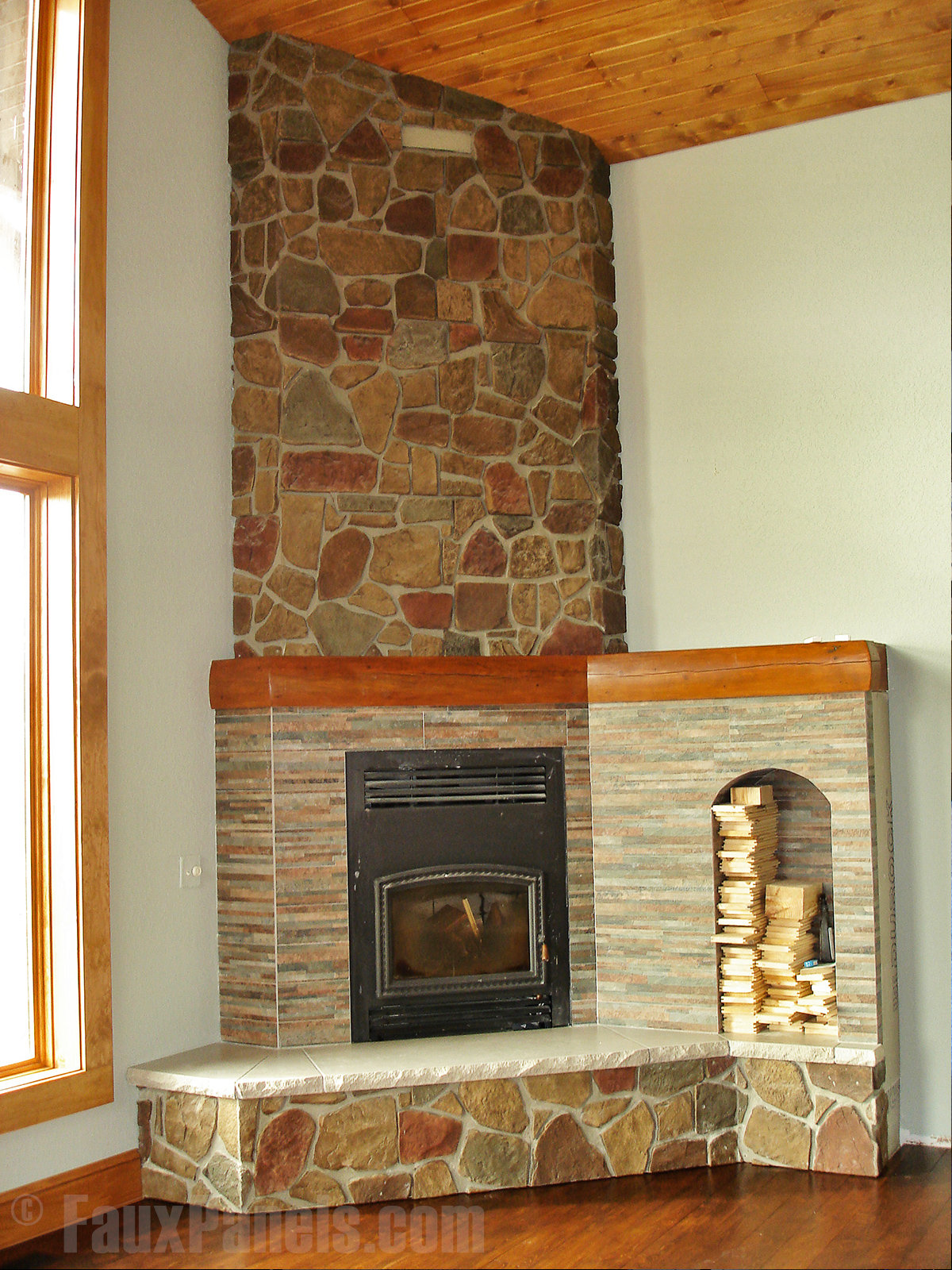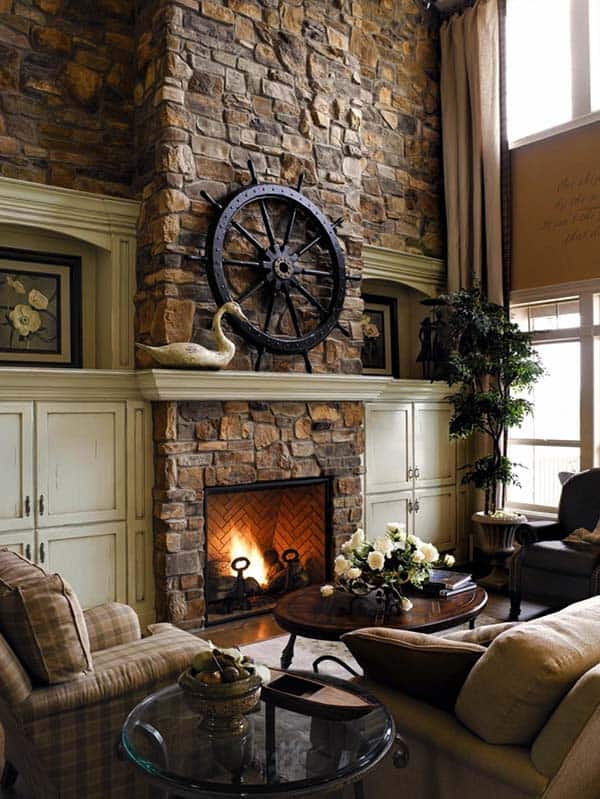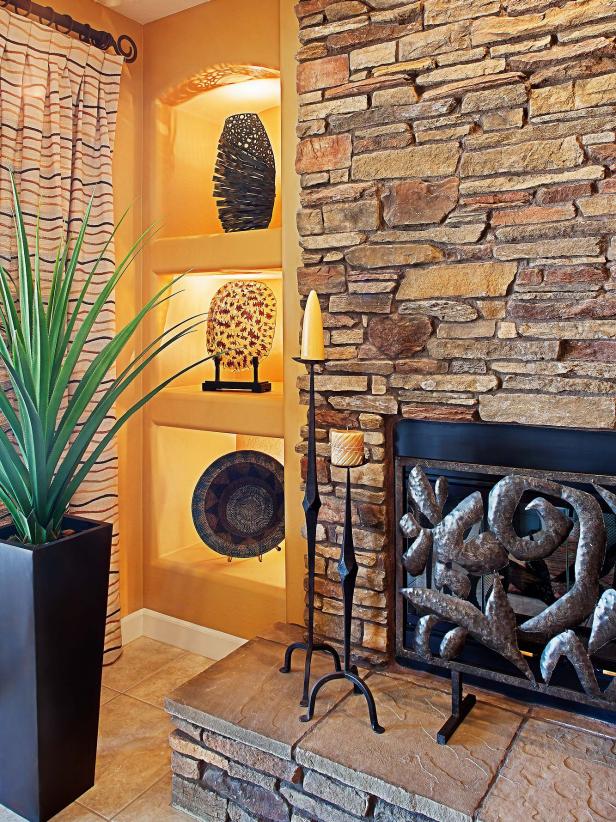Elevating Your Space with Natural Stone Fireplace Ideas
A natural stone fireplace is a timeless and captivating feature that can transform any room into a cozy, elegant haven. The natural textures, colors, and patterns found in stone add depth and character, making the fireplace a focal point that draws people in. Whether you prefer a rustic, traditional look or a sleek, modern design, natural stone offers endless possibilities.
Choosing the Right Type of Stone for Your Fireplace
Selecting the right type of stone for your fireplace is the foundation of your design. Each stone type brings its own unique texture, color palette, and aesthetic, so it’s important to choose one that aligns with your vision and complements the style of your home.

Limestone: Limestone is a popular choice for its soft, neutral tones and subtle texture. It’s often used in traditional or transitional designs, where it brings a sense of understated elegance. The natural veining in limestone can add visual interest without overwhelming the space, making it a versatile option for various decor styles.
Granite: Known for its durability and strength, granite is an excellent choice for a fireplace that needs to stand up to wear and tear. The speckled appearance of granite, with its mix of minerals, creates a striking visual effect. It’s available in a wide range of colors, from light grays and whites to deep blacks and reds, making it easy to find a shade that complements your decor.
Slate: Slate is prized for its rich, earthy tones and natural texture. Its layered appearance adds depth to any fireplace design, making it a popular choice for rustic or contemporary spaces. Slate’s natural resistance to heat and its non-porous nature also makes it a practical choice for a fireplace surround.

Marble: Marble exudes luxury and sophistication, with its smooth surface and distinctive veining. While it’s more commonly associated with traditional and classic designs, marble can also be used in modern settings to create a striking contrast with more minimalistic elements. Marble is available in a variety of colors, including the iconic white with gray veining, as well as shades of green, pink, and black.
Fieldstone: Fieldstone offers a rugged, natural look that’s perfect for rustic or cabin-style homes. The irregular shapes and sizes of fieldstone pieces create a sense of authenticity and connection to nature. The mix of colors found in fieldstone—from grays and browns to reds and blues—adds warmth and character to the fireplace.
Travertine: Travertine is known for its warm, earthy tones and distinctive pitted surface. This stone is often used in Mediterranean or Tuscan-inspired designs, where it brings a sense of old-world charm and elegance. The natural holes and troughs in travertine can be left unfilled for a more rustic look or filled for a smoother, more refined finish.

Designing for Style: Traditional vs. Modern Stone Fireplaces
The style of your natural stone fireplace can set the tone for the entire room. Whether you’re drawn to the classic appeal of a traditional design or the clean lines of a modern aesthetic, the choice of style will influence every aspect of your fireplace, from the type of stone to the overall layout.
Traditional Stone Fireplaces: Traditional stone fireplaces often feature detailed craftsmanship, with elements like mantels, hearths, and surrounds that showcase the beauty of the stone. These designs tend to be more ornate, with the stone often cut into uniform shapes and arranged in symmetrical patterns. Marble, limestone, and granite are popular choices for traditional fireplaces, as they offer a polished and refined look. The mantel is often a key feature in traditional designs, providing a surface for displaying art, photos, or decor.
Rustic Stone Fireplaces: A rustic stone fireplace embraces the natural, unrefined beauty of stone. The design often features large, irregular stones, such as fieldstone or slate, arranged in a way that feels organic and connected to the landscape. The fireplace may be paired with a thick wooden mantel or exposed beams to enhance the rustic vibe. This style is perfect for cabins, lodges, or any space where you want to create a cozy, earthy atmosphere.
Modern Stone Fireplaces: Modern stone fireplaces are characterized by clean lines, minimalistic design, and a focus on the natural beauty of the stone itself. The stone may be cut into large, sleek panels or left in its natural form for a more organic feel. Materials like granite, slate, or marble are often used in modern designs, as they offer a smooth, polished surface that complements the overall aesthetic. In modern settings, the fireplace is often integrated into a larger wall or structure, creating a seamless, cohesive look.

Transitional Stone Fireplaces: If you’re drawn to both traditional and modern styles, a transitional stone fireplace might be the perfect choice. This design blends elements from both styles, creating a look that’s both timeless and contemporary. For example, you might choose a classic stone like limestone or marble but pair it with clean lines and minimalistic decor. The result is a fireplace that feels fresh and modern, yet still retains a sense of warmth and tradition.
Industrial Stone Fireplaces: An industrial stone fireplace combines the raw, rugged appeal of stone with the edgy, unfinished look of industrial design. This style often features materials like concrete, steel, and exposed brick, paired with natural stone for contrast. The result is a fireplace that feels both bold and refined, making it a great choice for lofts, urban homes, or any space where you want to create a striking visual impact.
Eclectic Stone Fireplaces: For those who love to mix and match different styles, an eclectic stone fireplace offers endless possibilities. You might combine elements from various design styles, such as pairing a rustic stone hearth with a modern, minimalist mantel. The key to an eclectic design is balance—while it’s fun to experiment with different looks, the overall design should still feel cohesive and intentional.

Incorporating Functional Elements into Your Stone Fireplace Design
A natural stone fireplace can be as functional as it is beautiful. By thoughtfully incorporating practical elements into your design, you can enhance the usability of the fireplace while maintaining its aesthetic appeal. Whether it’s additional storage, seating, or media integration, there are many ways to make your stone fireplace a true centerpiece of your home.
Built-In Storage: One of the most popular functional additions to a stone fireplace is built-in storage. Shelving units, cabinets, or niches can be integrated into the fireplace surround, providing space to store firewood, books, or decorative items. These storage solutions can be designed to blend seamlessly with the stone, creating a cohesive look that enhances the overall design.
Seating Areas: Incorporating seating into your stone fireplace design can create a cozy, inviting atmosphere. A built-in bench or window seat next to the fireplace provides a perfect spot to relax and enjoy the warmth. This seating can be designed to match the style of the fireplace, whether it’s a rustic wooden bench or a sleek, modern seat with clean lines.
Media Integration: In today’s homes, the living room often doubles as a media room, so it’s important to consider how your fireplace will interact with your television and other electronic equipment. Many homeowners choose to mount their TV above the fireplace, creating a central entertainment hub. If you go this route, be sure to consider heat management and viewing height to ensure a comfortable and safe setup.

Fireplace Mantels: A mantel is both a functional and decorative element that can enhance the look of your stone fireplace. It provides a surface for displaying decor, such as candles, vases, or artwork, and can also serve as a ledge for hanging stockings during the holidays. The style of the mantel should complement the stone and the overall design of the fireplace, whether it’s a rustic wooden beam or a sleek, modern shelf.
Hearth Extensions: Extending the hearth beyond the fireplace opening can create additional seating or display space. A wide, low hearth made of stone provides a natural spot for people to sit and enjoy the fire. This extension can also serve as a display area for decor or even a place to store firewood, adding both functionality and visual interest to the fireplace.
Lighting Integration: Proper lighting is essential to highlight the beauty of your stone fireplace. Consider incorporating recessed lighting, wall sconces, or even LED strip lights into the design. These lights can be used to accentuate the texture and color of the stone, creating a warm and inviting atmosphere. Additionally, lighting can be integrated into shelving or niches to illuminate decorative items and enhance the overall ambiance of the room.

Exploring Different Layouts for Stone Fireplaces
The layout of your stone fireplace plays a crucial role in how it fits into your space and interacts with the rest of the room. Whether you’re designing a new fireplace from scratch or updating an existing one, the layout will influence the overall aesthetic and functionality. Here are some popular layouts to consider.
Central Fireplace: A central fireplace is a classic layout where the fireplace is positioned as the focal point of the room. This layout works well in both large and small spaces, as it draws attention to the fireplace and creates a natural gathering spot. The stone surround can extend from floor to ceiling, creating a dramatic effect that anchors the room.
Corner Fireplace: If you’re working with a smaller space or an awkward layout, a corner fireplace might be the perfect solution. Placing the fireplace in a corner can free up wall space for furniture and decor, while still providing a cozy focal point. The stone surround can be designed to wrap around the corner, creating a seamless transition between the two walls.
Two-Sided Fireplace: A two-sided, or double-sided, fireplace can be a striking feature that serves two rooms at once. This layout is ideal for open-concept spaces, where the fireplace can act as a divider between different areas, such as a living room and dining room. The stone surround can be designed to be visible from both sides, creating a cohesive look that ties the two spaces together.

Three-Sided Fireplace: A three-sided fireplace, also known as a peninsula fireplace, offers an even more dramatic effect. This layout allows the fire to be visible from three sides, creating a stunning focal point that can be enjoyed from multiple areas in the room. The stone surround can be extended on all three sides, creating a continuous, wrap-around effect that enhances the visual impact of the fireplace.
Freestanding Fireplace: For a truly unique design, consider a freestanding stone fireplace. This layout allows the fireplace to be placed anywhere in the room, making it a versatile option for both large and small spaces. The stone surround can be designed to encase the entire fireplace, creating a sculptural element that stands out as a centerpiece in the room.
Outdoor Stone Fireplace: Don’t limit your natural stone fireplace ideas to the indoors. An outdoor stone fireplace can be a beautiful and functional addition to your patio, garden, or backyard. This layout can be designed to complement the natural surroundings, using stones that blend with the landscape. An outdoor fireplace creates a perfect gathering spot for cool evenings, extending your living space into the great outdoors.

Incorporating Color and Texture in Stone Fireplace Designs
Color and texture are two of the most important elements in designing a natural stone fireplace. The right combination of these elements can elevate the fireplace from a simple feature to a stunning focal point that enhances the entire room. Understanding how to work with color and texture will help you create a fireplace that reflects your style and complements your home.
Monochromatic Schemes: A monochromatic color scheme involves using varying shades of the same color throughout the stone fireplace design. This approach can create a cohesive, harmonious look that feels elegant and sophisticated. For example, using different shades of gray stone, such as slate or granite, can create a subtle yet striking effect. The key is to choose stones with different textures to add depth and interest to the design.
Contrasting Colors: For a bolder look, consider using contrasting colors in your stone fireplace design. This can be achieved by pairing light and dark stones, such as white marble with black granite. The contrast between the two colors can create a dramatic effect that draws the eye and highlights the unique features of each stone. This approach works well in modern and contemporary designs, where the contrast adds a touch of sophistication and drama.
Natural Earth Tones: Natural earth tones, such as browns, tans, and reds, are a popular choice for stone fireplaces, as they bring warmth and a sense of coziness to the space. Stones like travertine, fieldstone, and sandstone often feature these tones, creating a fireplace that feels grounded and connected to nature. Pairing these stones with wood accents or warm lighting can enhance the inviting atmosphere.

Texture Variations: Texture plays a crucial role in the overall look and feel of your stone fireplace. Rough, textured stones, like fieldstone or slate, add a rugged, rustic charm, while smooth, polished stones, like marble or granite, bring a sense of refinement and luxury. Mixing different textures within the same design can create a dynamic and visually interesting fireplace that captures attention.
Patterned Stone Layouts: In addition to color and texture, the pattern in which the stones are laid can significantly impact the design. For example, a herringbone or chevron pattern can add a sense of movement and sophistication, while a random, irregular layout can create a more organic, natural look. Consider how the stone pattern will interact with the rest of the room’s design elements.
Accent Colors and Materials: Incorporating accent colors and materials into your stone fireplace design can add a unique touch that reflects your style. For instance, metal accents, such as a brass mantel or copper hearth, can add warmth and a touch of glamour. Alternatively, a wood mantel or built-in shelves can introduce a natural element that complements the stone. The key is to choose accents that enhance the stone’s natural beauty without overpowering it.

Personalizing Your Natural Stone Fireplace
A natural stone fireplace offers a unique opportunity to personalize your space and create a feature that reflects your style and taste. From custom carvings to unique mantels and creative decor, there are countless ways to make your fireplace truly your own.
Custom Stone Carvings: One way to personalize your stone fireplace is through custom carvings. Whether it’s a family crest, a favorite quote, or an intricate design, custom carvings can add a personal touch that makes your fireplace truly one-of-a-kind. Stone carvers can work with you to create a design that reflects your personality and enhances the overall aesthetic of the fireplace.
Unique Mantel Designs: The mantel is one of the most visible elements of a fireplace, so it’s a great place to add a personal touch. Consider choosing a mantel that reflects your style, whether it’s a reclaimed wood beam for a rustic look, a sleek metal shelf for a modern vibe, or a custom stone mantel that matches the fireplace surround. You can also personalize the mantel by decorating it with items that are meaningful to you, such as family photos, artwork, or heirlooms.
Creative Surrounds and Hearths: The surround and hearth are key components of your fireplace that can be customized to fit your style. Consider using a unique stone pattern or incorporating different materials, such as wood or metal, into the design. For example, a mosaic tile surround or a contrasting stone hearth can add visual interest and make your fireplace stand out.

Decorative Accents: Personalize your stone fireplace with decorative accents that reflect your interests and taste. This could include anything from antique candlesticks to modern sculptures, from a collection of vintage books to a display of seasonal decor. The key is to choose items that complement the style of the fireplace and add a touch of personality to the space.
Integrated Technology: In today’s homes, technology plays a big role in design, and your fireplace can be no exception. Consider integrating technology into your stone fireplace with features like built-in speakers, smart home controls, or even a hidden TV lift. These modern touches can make your fireplace not only a visual centerpiece but also a functional hub for entertainment and convenience.
Artwork and Displays: The wall above your stone fireplace is the perfect place to display artwork, whether it’s a single statement piece or a gallery of smaller works. Choose art that complements the colors and textures of the stone, and consider the scale of the artwork to the fireplace. This personal touch can help tie the room together and make the fireplace feel like an integral part of your home’s decor.

Common Mistakes to Avoid with Natural Stone Fireplaces
Choosing the Wrong Stone Type: Selecting a stone that doesn’t suit your lifestyle or climate can lead to maintenance issues and a look that doesn’t last. Always consider the durability and upkeep of the stone before making your choice.
Poor Installation Practices: Improper installation can lead to structural issues and aesthetic problems, such as uneven stone placement or visible seams. Hiring a skilled professional is essential to ensure a flawless installation.
Ignoring Heat and Ventilation Requirements: Overlooking the heat output of your fireplace and the necessary ventilation can result in damage to the stone and unsafe conditions. Ensure your fireplace is properly vented and that the stone can withstand the heat.
Mismatched Style: A stone fireplace that clashes with the rest of your home’s decor can feel out of place. Consider how the fireplace design fits with the overall style of your space to create a cohesive look.
Neglecting Maintenance: Natural stone requires regular cleaning and maintenance to keep it looking its best. Failing to maintain your fireplace can result in stains, discoloration, and deterioration over time.
Overcrowding the Mantel: Over-decorating the mantel can detract from the natural beauty of the stone and make the space feel cluttered. Keep the decor simple and let the stone be the star of the show.

What is the best stone for a fireplace?
The best stone for a fireplace depends on your style preferences, budget, and maintenance needs. Limestone, marble, and granite are popular choices for their durability and timeless appeal, while slate and fieldstone offer a more rustic, natural look. Each stone type has its unique characteristics, so it’s important to choose one that aligns with your design vision and practical considerations.
How do I clean and maintain a natural stone fireplace?
Cleaning and maintaining a natural stone fireplace involves regular dusting, wiping down the stone with a damp cloth, and using a mild detergent for tougher stains. Avoid harsh chemicals that could damage the stone’s surface. It’s also important to seal the stone periodically to protect it from stains and moisture, especially for more porous stones like limestone and travertine.
Can I install a natural stone fireplace myself?
While it’s possible to install a natural stone fireplace yourself, it’s generally recommended to hire a professional. Stone installation requires precision and expertise to ensure the stones are properly aligned, and secure, and that the fireplace functions safely. A professional can also help you choose the right stone and design for your space.

How do I choose the right stone color for my fireplace?
When choosing the color of your stone, consider the existing color scheme of your room and the overall style you want to achieve. Neutral tones like gray, beige, and white offer versatility and timelessness, while bolder colors can make a statement. It’s also important to consider how the stone’s color will change over time and under different lighting conditions.
Is natural stone a good insulator for fireplaces?
Yes, natural stone is an excellent insulator, helping to retain and radiate heat into the room. Stones like granite and limestone are particularly effective at absorbing and slowly releasing heat, making them ideal for fireplace surrounds. However, it’s important to ensure that the stone is installed with proper heat-resistant materials to prevent damage.
Can I use natural stone for an outdoor fireplace?
Absolutely! Natural stone is a great choice for outdoor fireplaces, as it can withstand the elements and adds a natural, rugged charm to outdoor spaces. Stones like slate, fieldstone, and travertine are popular for outdoor use. Just make sure the stone is properly sealed and maintained to protect it from weathering and moisture damage.
What are the costs associated with a natural stone fireplace?
The cost of a natural stone fireplace can vary widely depending on the type of stone, the complexity of the design, and the installation process. On average, natural stone fireplaces can range from $3,000 to $10,000 or more. High-end materials like marble will be on the pricier side, while more common stones like slate or limestone may be more affordable.

Related Posts: